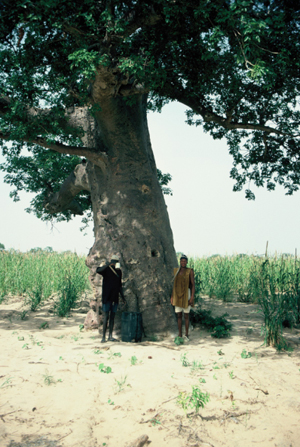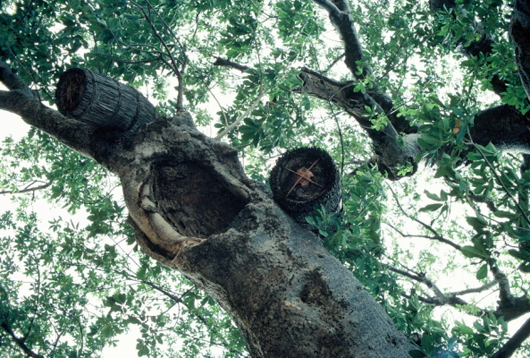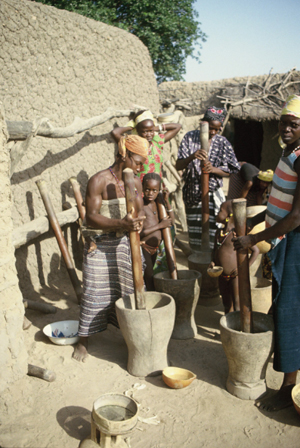Mali: Plants at the heart of everyday life
11.02.10 by Camilla Toulmin, IIED
The black of the night sky was thinning as Nyeli Tangara rolled out of bed, hitching her baby onto her back and collecting her rope and bucket. In the distance, she could hear the first thud-thud-thud of pestle and mortar, as women across the village began the rhythm of a new morning. She looped the rope around her shoulders, feeling in the half-light the patches where the thick plait made from baobab bark was starting to fray.
 She stooped before she left her courtyard to collect the embers under the blackened metal pot, and breathe life into them with a puff and handful of dried grass. The remains of last night’s millet porridge would do for her, heated up with the last few handfuls of dried baobab leaf, left over from last autumn’s harvest. She glanced at the dish prepared for the rest of the family, a favourite for them at the start of the rainy season when everyone feels the pressure of an early morning start to get out and sow the millet crop while moisture from the early rains still holds the sandy soil firm.
She stooped before she left her courtyard to collect the embers under the blackened metal pot, and breathe life into them with a puff and handful of dried grass. The remains of last night’s millet porridge would do for her, heated up with the last few handfuls of dried baobab leaf, left over from last autumn’s harvest. She glanced at the dish prepared for the rest of the family, a favourite for them at the start of the rainy season when everyone feels the pressure of an early morning start to get out and sow the millet crop while moisture from the early rains still holds the sandy soil firm.
She had spent much of the evening pounding and smoothing the flour into a light crumbly texture, and mixed it with the dried powder of baobab fruit, giving it a tart edge. It would have been good, she said to herself, to add a bit of n’tomi, but the pods were not yet ready for collecting on the big old tree she passed each day on the way out to the family’s fields.
 Setting off along the path to the well, she could see a huddle of women already pulling their buckets up and over the edge of the sill, the hard gwele wood indented with years’ of rope riding up and down against its trunk. She joined the circle, throwing her bucket down into the well, a short fall at this time of year with the rains lifting the water table. Her big metal basin quickly filled, she upended her calabash bowl in its centre to stop the water swilling and sloshing as she carried it back home on her head. Three visits to the well should be enough for the moment, the men having washed last night and being eager to get off to sow the millet.
Setting off along the path to the well, she could see a huddle of women already pulling their buckets up and over the edge of the sill, the hard gwele wood indented with years’ of rope riding up and down against its trunk. She joined the circle, throwing her bucket down into the well, a short fall at this time of year with the rains lifting the water table. Her big metal basin quickly filled, she upended her calabash bowl in its centre to stop the water swilling and sloshing as she carried it back home on her head. Three visits to the well should be enough for the moment, the men having washed last night and being eager to get off to sow the millet.
 Once she’d filled her big earthenware pot, she took the brush, a handful of wuluku grass cut from the side of the field path, and swept clear the courtyard, fetching the rubbish into a calabash crock and carrying it out to the pile she would take out to her own little plot later in the day.
Once she’d filled her big earthenware pot, she took the brush, a handful of wuluku grass cut from the side of the field path, and swept clear the courtyard, fetching the rubbish into a calabash crock and carrying it out to the pile she would take out to her own little plot later in the day.
It was almost fully light now, and the men were stirring, young boys with eyes still heavy from sleep shrouded in the rough cotton cloth she and her daughter had spun. Buying the sack of cotton was a big expense each year – she wished they could still harvest their own, but it must be 30 years or more since she’d last seen any cotton growing in this part of the country. The shorter, more erratic rains had put paid to that. There were even years when the harvest of groundnuts gave no more than what had been sown, and the millet crop had been pitifully thin. Then, they had spent much of the long hot dry season fanned out across the countryside, getting work when they could and collecting those hard green seeds from the bere. What a labour it had been to soak, boil and press them! But without the soaking, their harsh taste would have made them inedible, and racked their stomachs with pain.
page 1
page 2 >
Related links:
Africa: UK Government shows ongoing commitment to African agriculture
03.12.09
![]() As the Copenhagen Climate Conference looms nearer, the scars left by a changing climate are being felt across the world.
As the Copenhagen Climate Conference looms nearer, the scars left by a changing climate are being felt across the world.
Africa: Trees changing attitudes and lives
28.06.09
 2009 is a critical year for forests and efforts to mitigate climate change could be strengthened if nations agree to protect the world's forests.
2009 is a critical year for forests and efforts to mitigate climate change could be strengthened if nations agree to protect the world's forests.